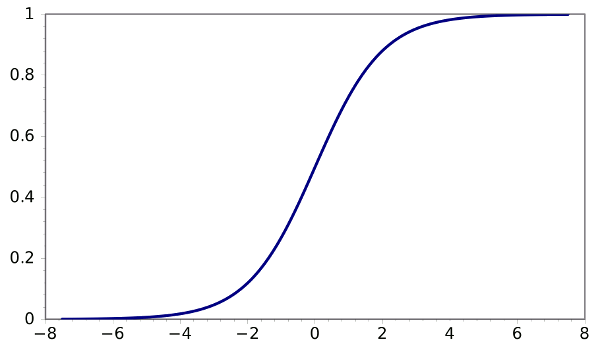
The S-Curve
August 1, 2011 Many things in nature and human culture follow an "S"-shaped development. The curve that describes this is usually known as the S-curve, or sigmoid function. Things start slowly, they accelerate quickly after a time, and then they saturate. The logistic function, the most used sigmoid function, is easily written and calculated,S(t) = 1/(1 + e-t)in which S(t), the sigmoid function of t, as can be seen in the graph below, ranges from zero to one. The independent variable is usually named t, since most references to the function refer to time. A time t = 0 specifies when we're halfway up the curve. The units of t can be scaled so that it makes sense in a given problem, so we can write kt instead of t.
 The sigmoid function, 1/(1+exp(-t)). Graph via Gnumeric.
One example of the S-curve in action, the technology S-curve, should be familiar to readers of this blog. It all starts with an invention, when a barely functional device is produced. As development continues, the performance reaches an acceptable level, and continued development hones the invention into a useful gadget. Finally, no matter how hard you try, you can't make significant improvement, so progress stops. This process can be summarized, as follows:
The sigmoid function, 1/(1+exp(-t)). Graph via Gnumeric.
One example of the S-curve in action, the technology S-curve, should be familiar to readers of this blog. It all starts with an invention, when a barely functional device is produced. As development continues, the performance reaches an acceptable level, and continued development hones the invention into a useful gadget. Finally, no matter how hard you try, you can't make significant improvement, so progress stops. This process can be summarized, as follows:
Invention -> Technology Improvement -> Mature Technology -> Aging TechnologyFor argument's sake, the transition points between these stages can be considered to be at S(t) = 0.05, 0.75 and 0.95. In economics, the process is known as the diffusion of innovations. Examples in economics are provided by Arnulf Grübler, who showed that the spread of large capital projects, such as canals, railroads and highways, follows the S-curve.[1]
 | The cumulative distribution function, (1/2)(1+erf(t)), where erf() is the error function. The cumulative distribution function has a sigmoid shape. Graph via Gnumeric. |
"Ever-newer waters flow on those who step into the same rivers." (More colloquially, "You can't step twice in the same river twice.")In their JAP paper, Bejan and Lorente see an analogy of "S"-curve phenomena and how flow systems modify their designs over time to continue their flow in the face of friction and other obstacles. Bejan first posited his flow principle about fifteen years ago, and he's been developing it ever since.[3] To quote from their paper, "For a finite size flow system to persist in time (to live), its configuration must evolve such that it provides easier and easier access to its currents."[2] The essential point of the model is that flow systems start with direct channels, but these channels branch over time. The initial channels penetrate the region quickly, but it's then necessary to access slower flows from branches. Eventually, when the branching mechanism extends as far as it can, flow reaches a maximum. The paper has a few descriptive equations, but this is more of a concept, an analogy, than an easily applied model. One interesting example used in the paper involves petroleum extraction. Early wells had a single pipe in the ground, and that evolved to oil fields with many pipes in the ground. Now, as illustrated in one figure of their paper, oil well piping has underground branches that resemble a river with tributaries.[2] The research was supported by the National Science Foundation, the U.S. Air Force Office of Scientific Research and the National Renewable Energy Laboratory.[3]
"All things move and nothing remains still."
References:
- Arnulf Grübler, "The Rise and Fall of Infrastructures: Dynamics of Evolution and Technological Change in Transport," International Institute for Applied Systems Analysis (1999), 305 pages. A PDF file appears to be available here.
- A. Bejan and S. Lorente, "The constructal law origin of the logistics S curve," Journal of Applied Physics, vol. 110, no. 2 (July 20, 2011), Document No. 024901 (4 pages)
- Richard Merritt, "Seeing the S-Curve in Everything, " Duke University Press Release, July 20, 2011.
- YouTube video: Adrian Bejan describes the constructal theory of generation of design in nature at Bucharest Conference.
- A. Bejan and S. Lorente, "The constructal law origin of the logistics S curve," Journal of Applied Physics, vol. 110, no. 2 (July 20, 2011), Document No. 024901 (4 pages)
